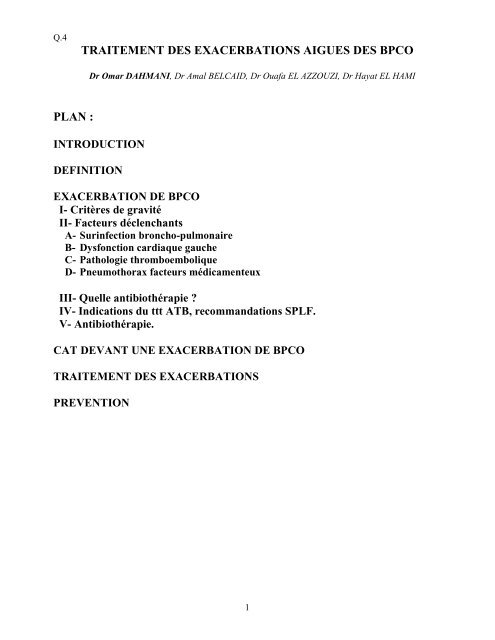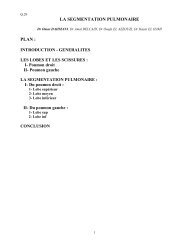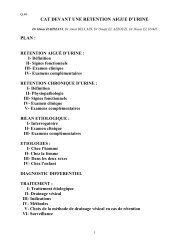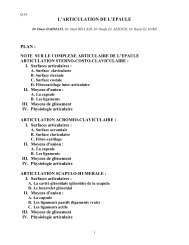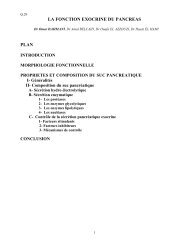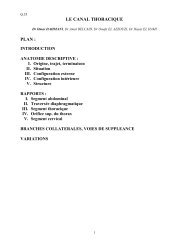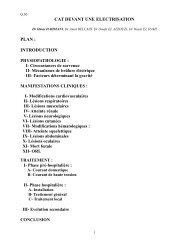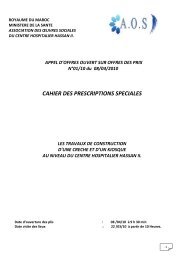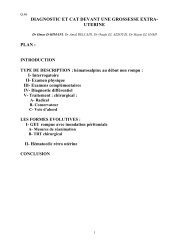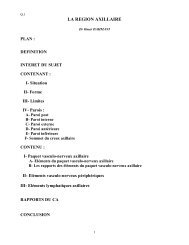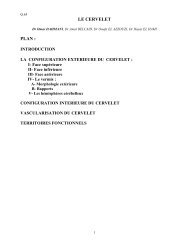TRAITEMENT DES EXACERBATIONS AIGUES ... - CHU Hassan II
TRAITEMENT DES EXACERBATIONS AIGUES ... - CHU Hassan II
TRAITEMENT DES EXACERBATIONS AIGUES ... - CHU Hassan II
Create successful ePaper yourself
Turn your PDF publications into a flip-book with our unique Google optimized e-Paper software.
Q.4<br />
PLAN :<br />
<strong>TRAITEMENT</strong> <strong>DES</strong> <strong>EXACERBATIONS</strong> <strong>AIGUES</strong> <strong>DES</strong> BPCO<br />
Dr Omar DAHMANI, Dr Amal BELCAID, Dr Ouafa EL AZZOUZI, Dr Hayat EL HAMI<br />
INTRODUCTION<br />
DEFINITION<br />
EXACERBATION DE BPCO<br />
I- Critères de gravité<br />
<strong>II</strong>- Facteurs déclenchants<br />
A- Surinfection broncho-pulmonaire<br />
B- Dysfonction cardiaque gauche<br />
C- Pathologie thromboembolique<br />
D- Pneumothorax facteurs médicamenteux<br />
<strong>II</strong>I- Quelle antibiothérapie ?<br />
IV- Indications du ttt ATB, recommandations SPLF.<br />
V- Antibiothérapie.<br />
CAT DEVANT UNE EXACERBATION DE BPCO<br />
<strong>TRAITEMENT</strong> <strong>DES</strong> <strong>EXACERBATIONS</strong><br />
PREVENTION<br />
1
<strong>TRAITEMENT</strong> <strong>DES</strong> <strong>EXACERBATIONS</strong> <strong>AIGUES</strong> <strong>DES</strong> BPCO<br />
Dr Omar DAHMANI, Dr Amal BELCAID, Dr Ouafa EL AZZOUZI, Dr Hayat EL HAMI<br />
INTRODUCTION :<br />
- Problème majeur de santé publique.<br />
- Conséquence directe du tabagisme.<br />
- Ampleur sous estimée.<br />
- Prévalence, morbidité et mortalité variables, importantes.<br />
DEFINITION :<br />
BPCO = état pathologique caractérisé par un TVO incomplètement réversible. Le TVO est<br />
habituellement progressif, et associé à une réponse inflammatoire anormale du poumon vis-à-vis d’aéro<br />
contaminants.<br />
Bronchite chronique et/ou emphysème.<br />
Asthme et DDB exclus.<br />
EXACERBATION DE BPCO :<br />
I- Critères de gravité :<br />
Terrain :<br />
Oxygénothérapie au long cours.<br />
Comorbidité.<br />
Clinique :<br />
Œdème des membres inférieurs.<br />
FR> 25c/min ; pouls> 110b/min.<br />
Cyanose (en particulier si elle s’étend).<br />
Troubles des fonctions supérieures.<br />
Astérixis.<br />
Utilisation des muscles respiratoires accessoires.<br />
Respiration paradoxale.<br />
Troubles de vigilance, coma, choc.<br />
Fonctionnelle :<br />
DEP < 100l/min<br />
Gazométrie :<br />
PaO2 < 60mmHg, alarmant si < 45mmHg.<br />
PaCO2 > 45mmHg, alarmant si > 70mmHg.<br />
pH < 7,30.<br />
<strong>II</strong>- Facteurs déclenchants :<br />
A- Surinfection broncho-pulmonaire (mécanisme le plus fréquent)<br />
Origine virale 30%.<br />
Germes atypiques 5-10% C.pneumoniae+++.<br />
Germes usuels 50 à 75% : H.influenzae, S.pneumoniae, M.catarrhalis + pseudomonas, BGN,<br />
staphylocoque.<br />
B- Dysfonction cardiaque gauche :<br />
Rechercher toujours un facteur<br />
2
Autonome.<br />
Induite par HTAP.<br />
C- Pathologie thromboembolique :<br />
Circonstances favorisantes.<br />
Sémiologie thoracique ou extra thoracique.<br />
Signes droits majeurs.<br />
Diminution de PCO2, aggravation clinique.<br />
Examens complémentaires ??<br />
Discuter un ttt anticoagulant.<br />
D- Pneumothorax :<br />
Cause rare.<br />
Mal toléré, drainage thoracique.<br />
Différencier entre pneumothorax et bulle d’emphysème (TDM).<br />
E- Facteurs médicamenteux :<br />
Difficile à prouver.<br />
Antidépresseurs, anxiolytiques.<br />
Prescription abusive des diurétiques.<br />
Antitussifs.<br />
Erreurs de gestion d’une oxygénothérapie longue durée (OLD).<br />
<strong>II</strong>I- Quelle antibiothérapie ?<br />
Prescription abusive.<br />
Pression des malades.<br />
Bénéfice douteux, coût élevé.<br />
Aucun consensus.<br />
Prescription inappropriée, résistances.<br />
IV- Indications du ttt ATB, recommandations SPLF :<br />
A- Origine infectieuse très probable :<br />
- Fièvre plus un ou plusieurs des signes suivants : apparition ou aggravation de dyspnée.<br />
- Apparition ou augmentation du volume de l’expectoration, purulence.<br />
B- Origine probable :<br />
- Infection des voies aériennes supérieures plus un ou plusieurs éléments définissant l’exacerbation.<br />
C- Origine possible :<br />
- Un ou deux éléments définissant l’exacerbation.<br />
Origine<br />
infectieuse de<br />
l’exacerbation<br />
Bronchite chronique<br />
simple<br />
Bronchite chronique<br />
obstructive<br />
3<br />
BCO avec insuffisance<br />
respiratoire<br />
Très probable R R R<br />
Probable D R R<br />
Possible NR D R<br />
V- Antibiothérapie :<br />
En première intention :<br />
Amoxicilline orale 3g/j.<br />
gauche<br />
A évoquer<br />
systématiquement
Amoxiclav 2 à 3g/j.<br />
En seconde intention :<br />
Fluoro quinolones 2 ème génération.<br />
Bétalactamine + (macrolide ou quinolone).<br />
Fluoro quinolone 3 ème génération.<br />
Absence de gravité,<br />
absence de comorbidité<br />
CAT DEVANT UNE EXACERBATION DE BPCO<br />
Poursuite du ttt<br />
Réduction des<br />
doses.<br />
Réévaluer p.e.c<br />
au long cours<br />
Exacerbation peu<br />
sévère.<br />
ttt ambulatoire<br />
↑ des β2 mimétiques<br />
Eviter hypnotiques, sédatifs, antitussifs<br />
Informer des signes de gravité<br />
Discuter antibiothérapie<br />
Amélioration en 48h<br />
OUI NON<br />
OUI<br />
Hospitalisation<br />
<strong>TRAITEMENT</strong> <strong>DES</strong> <strong>EXACERBATIONS</strong> :<br />
Les modalités de PEC dépendent de la sévérité de la maladie et de l’exacerbation, ainsi que de la cause<br />
déclenchante.<br />
1- O2 faible débit (pour ne pas aggraver l’hypercapnie éventuelle), jusqu'à atteindre une saturation à<br />
90% et une PaO2 à + de 60mmHg.<br />
2- Traitement anticoagulant préventif : Calciparine 0,2ml 3 fois/j en SC en cas d’alitement prolongé ou<br />
de polyglobulie avec surveillance biologique.<br />
3- β2 agonistes en nébulisation associés aux anticholinergiques.<br />
4- Corticothérapie par voie parentérale : 0,5-1mg/kg/j de prednisolone pdt 5 jours et relais par voie orale<br />
(durée totale de 10 jours).<br />
5- Correction d’une alcalose métabolique ou d’une hypokaliémie éventuelles.<br />
6- Diurétiques en cas d’inflation hydrosodée.<br />
4<br />
Corticothérapie<br />
Per os<br />
Amélioration<br />
48h<br />
NON
7- Ventilation artificielle : en cas de troubles de la conscience, coma, augmentation de la PaCO2 avec<br />
acidose non compensée.<br />
8- Traitement de la cause :<br />
Pneumothorax.<br />
Embolie pulmonaire.<br />
Infection.<br />
Insuffisance ventriculaire gauche.<br />
Bronchospasme.<br />
PREVENTION :<br />
Lutte contre le tabac+++<br />
Eradication des foyers infectieux (dentaires, sinusiens)<br />
Vaccination antigrippale tous les ans.<br />
Vaccination antipneumococcique tous les 5 ans.<br />
Eviter les antitussifs, les sédatifs, les hypnotiques.<br />
<br />
5


